
Exploring Hokkaidō’s Shiretoko: Lakes, Wild Shorelines, and More
Guideto Japan
- English
- 日本語
- 简体字
- 繁體字
- Français
- Español
- العربية
- Русский
A large swath of the Shiretoko Peninsula and its surrounding marine area was inscribed as a UNESCO World Natural Heritage site in July 2005. Located in eastern Hokkaidō, it also has two major towns, Shari to the west and Rausu to the east. The main tourism center is Utoro, located in Shari, an ideal base from which to explore the peninsula’s eight top scenic spots. Each one has its own character and seasonal attractions that attract repeat visitors and long-term stayers alike.
With the exception of Cape Shiretoko, all of the eight sights covered in this two-part series are on the western, Shari side of the peninsula, and do not include sights on the eastern, Rausu side. Three of the eight sights—Oshinkoshin Falls, the rock of Oronkoiwa, and the Yūhidai observation point—lie outside the World Heritage-listed area, but are well worth the trip as well.
1. Shiretoko Five Lakes: A World Natural Heritage Hotspot
The Shiretoko Goko, or Five Lakes, are surrounded by primeval forest that provides a habitat for a rich range of wild fauna and set against the scenic backdrop of the Shiretoko mountain range. Originally nameless, the five marsh lakes were dubbed Lake One to Lake Five when the area was being upgraded for tourists, and have since become a must-see for most visitors to Shiretoko. The mirage-like images of the mountain range and untouched forest reflected on the lake surfaces is a sight to behold.
 An aerial view of the Shiretoko Five Lakes with the elevated boardwalk (lower right) connecting the parking area to the lakes. (Courtesy of Shiretoko Shari-chō Tourist Association)
An aerial view of the Shiretoko Five Lakes with the elevated boardwalk (lower right) connecting the parking area to the lakes. (Courtesy of Shiretoko Shari-chō Tourist Association)
An 800-meter raised boardwalk extends from the Five Lakes parking area to Lake One. It is equipped with an electric fence to prevent animals from entering, so visitors can wander its length at their ease. Entrance is free of charge throughout the season.
 The Shiretoko mountain range is reflected on the surface of Lake One.
The Shiretoko mountain range is reflected on the surface of Lake One.
There are regular walking trails for those wanting to explore the area on foot. However, other than over a short period in the fall, you must listen to a lecture at the Shiretoko Goko Lakes Field House adjacent to the parking area before you head out. When the local brown bears are active, between May 10 and July 31, you can only walk if led by a specially trained guide. The area is also closed when there are bear sightings, so it is best to check the official website before setting out.
Along the trails, you are likely to see bear pawprints, black woodpecker meal scraps, or other traces of the rich fauna in residence, while you may even encounter Hokkaidō deer, Hokkaidō squirrels, or other species native to the area.
 A palette of fall colors is reflected on Lake Four.
A palette of fall colors is reflected on Lake Four.
In recent years, a midwinter “ecological” tour of the lakes has become a popular new activity. It enables visitors to enter the Five Lakes area when it is normally closed for winter and walk across the frozen lakes with a snow-covered mountain backdrop.
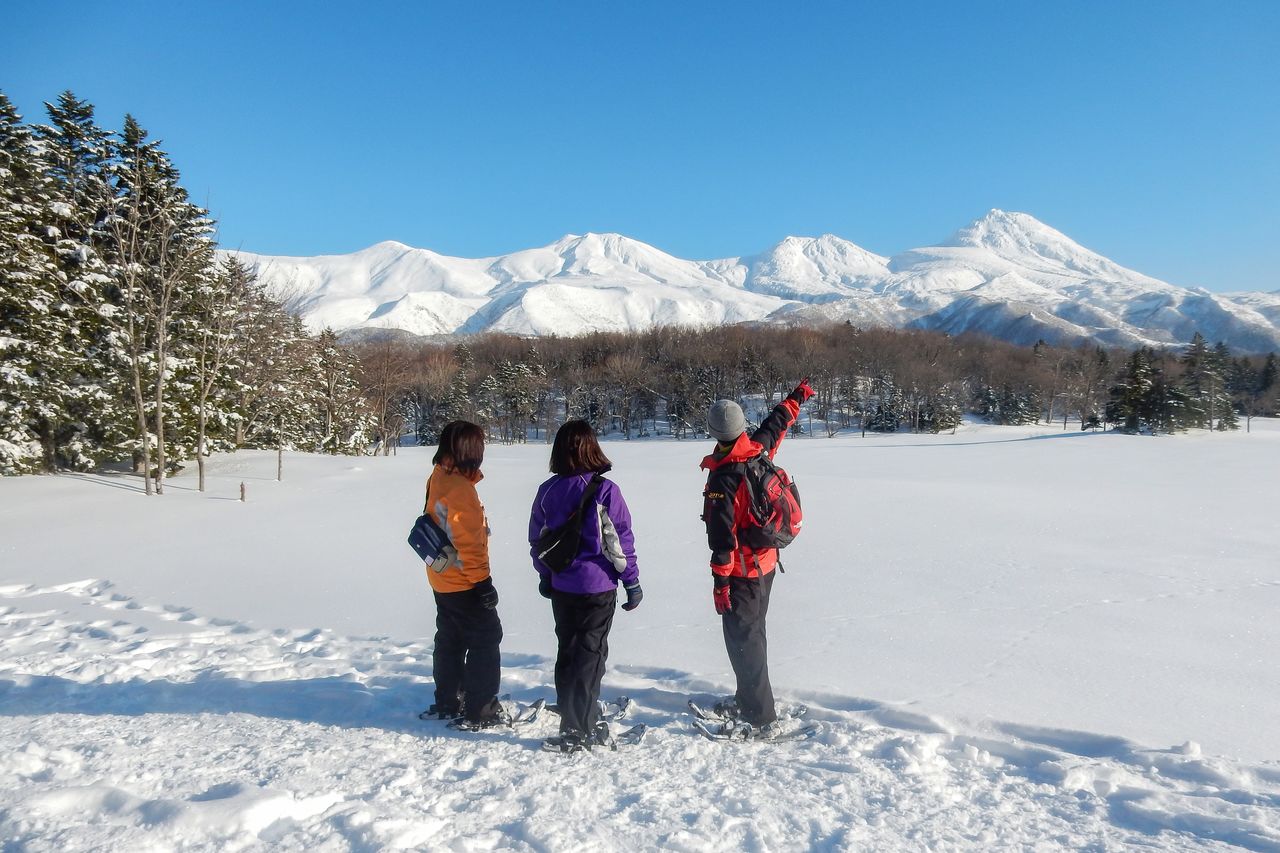 On a winter eco tour. (Courtesy of Shiretoko Shari-chō Tourist Association)
On a winter eco tour. (Courtesy of Shiretoko Shari-chō Tourist Association)
DATA
- Access: 14 km from Utoro (20 min drive); 25 min by bus from Utoro Onsen Bus Terminal
- Open: Late April to late November (in winter, guided tours only)
- Website: https://www.goko.go.jp/multilingual_eng/index.html (also available in simplified and traditional Chinese and Korean)
2. Cape Puyuni: Majestic Views from the World Heritage Gateway
As you travel along National Highway 334 from Utoro in the direction of Shiretoko Five Lakes and Shiretoko Pass, the Horobetsu Bridge acts as the gateway to the World Heritage–listed section of the peninsula. Just after it lies Cape Puyuni, which offers views of the town and harbor of Utoro, as well as magnificent sunsets.
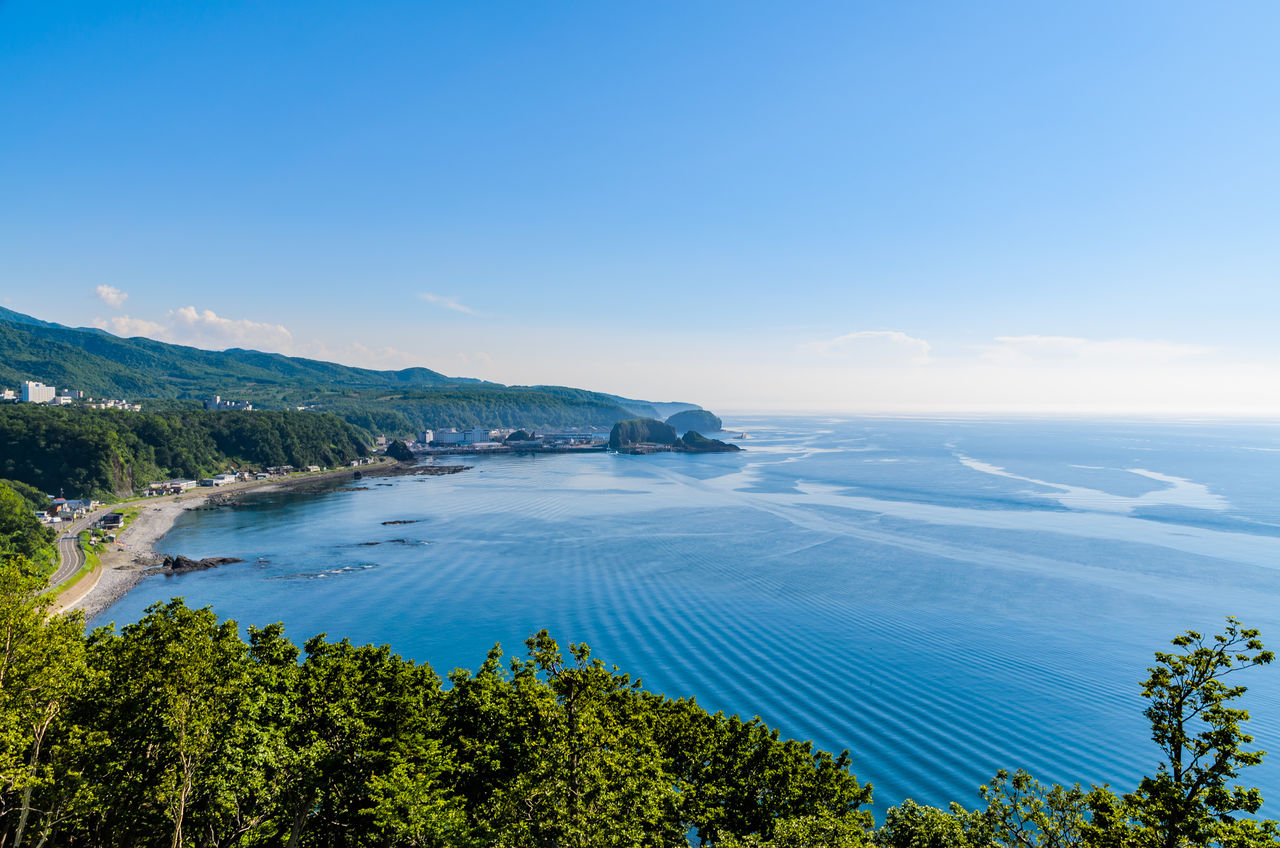 A peaceful, summer vista from Cape Puyuni, with the rippling wake of a sightseeing boat.
A peaceful, summer vista from Cape Puyuni, with the rippling wake of a sightseeing boat.
Hokkaidō deer are a common sight around the cape, and if you are lucky, you might also catch a glimpse of a white-tailed eagle or sea eagle. This is also one of the first places that drift ice appears in the Sea of Okhotsk, and it can be fully packed with ice at times. Walking across the drift ice in a dry suit has become a popular activity for visitors in the coldest winter months.
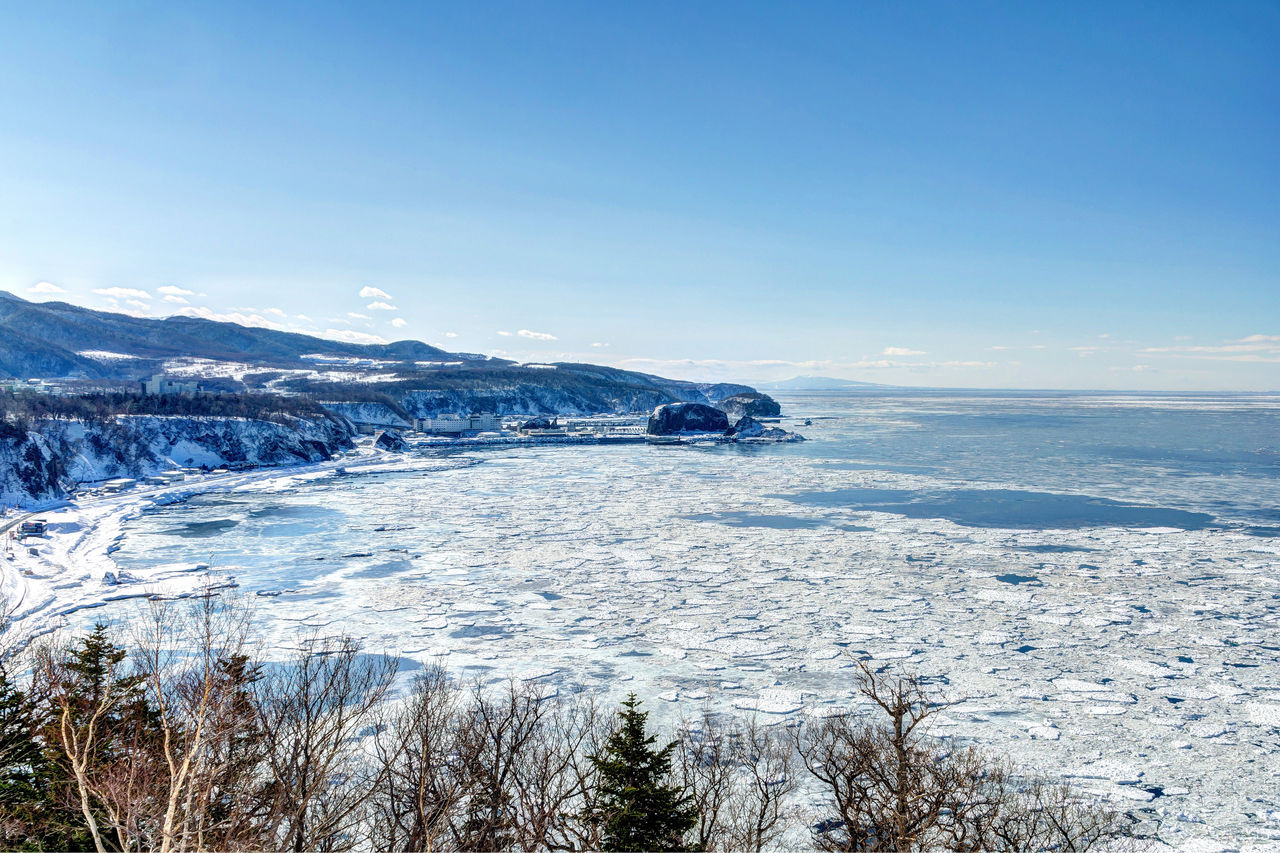 Cape Puyuni in winter with the sea coated in drift ice.
Cape Puyuni in winter with the sea coated in drift ice.
 Cape Puyuni is also famous for its magnificent sunsets. (Courtesy of Shiretoko Shari-chō Tourist Association)
Cape Puyuni is also famous for its magnificent sunsets. (Courtesy of Shiretoko Shari-chō Tourist Association)
DATA
- Access: 4 km from Utoro (5 min drive)
3. Oronkoiwa: An Utoro Landmark
Oronkoiwa is a huge, mountain-like rock near Utoro harbor. At a height of around 60 meters, it requires a 170-step climb to the top for a superb view of the Utoro township and the Shiretoko mountains. The sea-facing rock face is a breeding ground for seagulls and other bird life.
 The mighty Oronkoiwa makes its presence felt. (Courtesy of Shiretoko Shari-chō Tourist Association)
The mighty Oronkoiwa makes its presence felt. (Courtesy of Shiretoko Shari-chō Tourist Association)
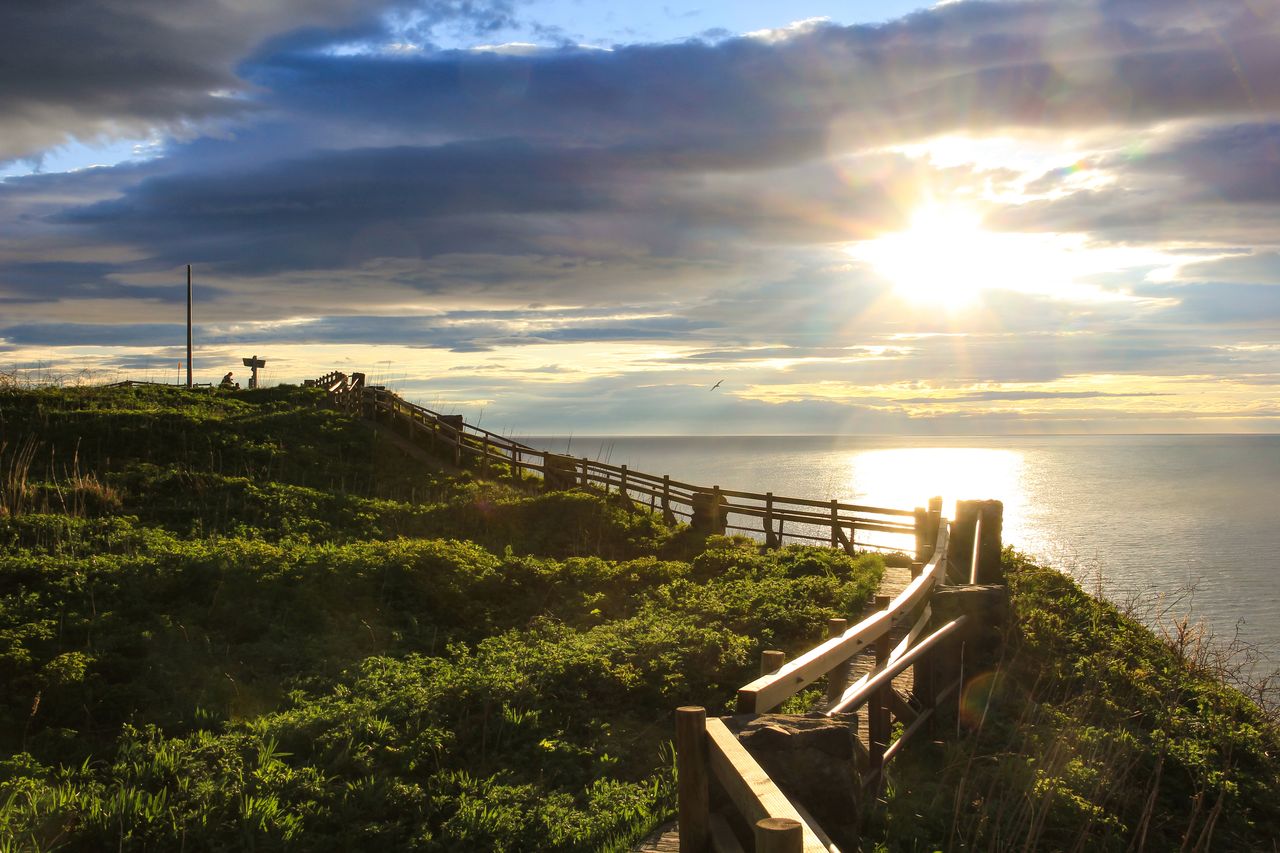 Climbing Oronkoiwa affords fabulous sunset views. (Courtesy of Shiretoko Shari-chō Tourist Association)
Climbing Oronkoiwa affords fabulous sunset views. (Courtesy of Shiretoko Shari-chō Tourist Association)
On passing through the tunnel in the massive rock, you will find a monument to Matsuura Takeshirō, the nineteenth-century explorer who gave Hokkaidō its name, as well as another more modern monument to the popular karaoke number, “Shiretoko Love Song.” The name “Oronkoiwa” means “the rock that sits there” in an Ainu language, and is thought to be derived from the indigenous Oronko people, who inhabited this area.
 Oronkoiwa is reflected in the mirrorlike sea on a still day. (Courtesy of Shiretoko Shari-chō Tourist Association)
Oronkoiwa is reflected in the mirrorlike sea on a still day. (Courtesy of Shiretoko Shari-chō Tourist Association)
DATA
- Access: 5 min walk from Utoro Onsen Bus Terminal
- Open: Late April to early December (when there is no snow)
4. Yūhidai: Golden Sunsets over the Sea of Okhotsk
Yūhidai, or Sunset Point, is an elevated observation point offering panoramic views of Utoro. True to its name, it attracts crowds every day before sundown. The pre-twilight attraction is one of nature’s magical moments when the slowly sinking orb of the sun turns the sea and sky a fiery orange.
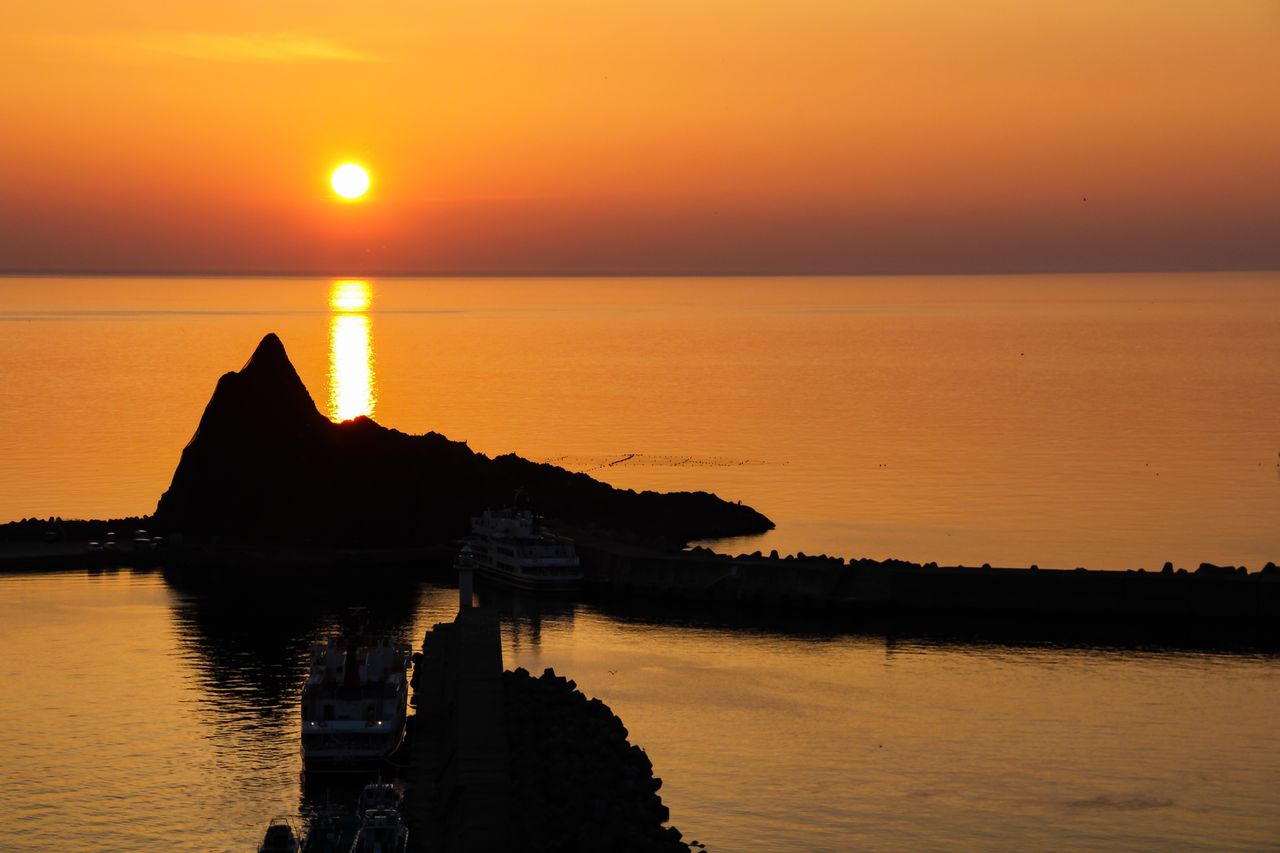 Sea and sky take on the golden hues of sunset. (Courtesy of Shiretoko Shari-cho Tourist Association)
Sea and sky take on the golden hues of sunset. (Courtesy of Shiretoko Shari-cho Tourist Association)
On some days in winter, the setting sun sinks below the drift ice, drenching the ice-covered sea in the rich colors of sunset.
Yūhidai attracts many campers in the summertime, given its location in the grounds of the Shiretoko National Camping Ground. A number of nearby facilities with yūhi (sunset) in their name—such as the Yūhidainoyu public bath house and Yūhi no Ataruie Onsen Hostel—are also popular with visitors.
 Nature’s palette put to full use just as the sun sinks below the horizon.
Nature’s palette put to full use just as the sun sinks below the horizon.
DATA
- Access: 15 min walk from Utoro Onsen Bus Terminal
(Originally written in Japanese. Banner photo: Shiretoko mountain range reflected in Lake One. Reporting and text by Laufen Katsu. Photos © Shiretoko Shari-chō Tourist Association and Laufen Katsu.)